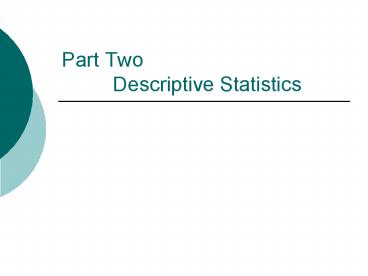Part Two Descriptive Statistics PowerPoint PPT Presentation
1 / 22
Title: Part Two Descriptive Statistics
1
Part Two Descriptive Statistics
2
Chapter Two
- Organizing and Graphing Data
3
Two Types of Variables
- Qualitative (categorical)
- Quantitative
- a) Discrete
- b) Continuous
4
Organizing data
- Class
- Frequency
- Relative frequency (probability, proportion,
percent,area) - Cumulative frequency
- Cumulative relative frequency
5
Graphs for Qualitative Data
- Pie Chart (Circle graph)
- Bar Chart
- Demo - Bar/Pie Graphs
- Demo - Breakfast Drinks
6
Circle Graph (Pie Chart)
- 1) Establish your class
- 2) Count the frequency of each class
- 3) Compute the relative frequency of each class
- 4) Multiply the relative frequency by 360 degrees
- 5) Mark off the resultant number of degrees for
each class on the circle
7
Graphs for Quantitative Data- 2.2
- Pie charts
- Bar Charts
- Time Series
- Line Charts
- Dot Plots
- Stem and Leaf Plots
- Relative Frequency Histograms
8
Numerical Measures of Central Tendency - mean
- Arithmetic Mean the sum of the measurements
divided by the total number of measurements - Population symbol for mean is µ
- ( µ is a parameter)
- The symbol for the mean of a sample is x bar
( x bar is a statistic)
9
Other Measures of Central Tendency
- Mode the most popular ( the data item that
occurs the most often) - Median when data is ranked, the median is the
middle piece of data. When there is an even
amount of data, the two middle pieces of data are
added together and divided by two. - Midrange the highest plus lowest data entries
divided by two. - Demo-Mean vs. Median Applet
10
Measures of Variability
- Range the highest data item minus the lowest
data item - Variance
- Population variance - s² (parameter)
- Sample variance - s² (statistic)
- Standard Deviation
- Population Std Dev. - s (parameter)
- Sample Std. Dev. s (statistic)
- Demo-Standard Deviation
11
Histograms With Different Characteristics
- Normal
- Approximately normal
- Skewed right
- Skewed left
- Uni-modal
- Bi-modal
- Gap
- Data Far from others
- How Class Width Affects a Histogram
12
Chebyshevs Rule
- Applies to ANY data set
- No useful information is provided for the
fraction of measurements that fall within one
standard deviation of the mean. - At least ¾ of all data will fall within 2
standard deviations of the mean. - At least 8/9 of all of the measurements will fall
within 3 standard deviations of the mean. - Generally, of the measurements
- will lie within k standard deviations of the
mean
13
Empirical Rule
- Applies to a normal or approximately normal data
set - 68.2 of data will fall within 1 standard
deviation of the mean - 95.4 of the data will fall within 2 standard
deviations of the mean - 99.7 of the data will fall within 3 standard
deviations of the mean - Empirical Rule
14
Approximating the Standard Deviation
- The standard deviation should be somewhere
between ¼ and 1/6 of the range
15
Numerical Measures of Relative Standing
- Percentiles for any set of n measurements (
arranged in ascending or descending order), the
pth percentile is a number such that p of all
measurements fall below the pth percentile and
(100-p) fall above the number. - Z-scores for a normal or approximately normal
distribution, the z-score of a measurement is the
distance between the score and the mean of the
distribution expressed in standard deviations - Finding area using Z-scores
16
Example of Finding a Z-Score
- The length of time that a pregnancy
- lasts has a mean of 266 days and a standard
deviation of 16 days. Find the z-score for a
pregnancy that lasts 294 days.
17
Outliers Section 2.8
- Outlier an observation that is unusually large
or small relative to the other values in the data
set. - Causes of Outliers
- a) the measurement is incorrectly observed,
recorded, or entered into a computer - b) the measurement comes from a different
population - c) the measurement is correct but represents a
rare event
18
Definitions Section 2.8
- Lower Quartile ( also called first quartile)
the First Quartile is the same as the 25th
percentile. - Median, Second Quartile, or Middle Quartile the
same as the 50th percentile - Upper Quartile, Third Quartile the same as the
75th percentile - Interquartile range Third Quartile minus the
First Quartile
19
Box Plot Method to Determine Outliers Section
2.8
- Rectangle with ends (hinges) drawn at the first
and Third Quartiles - 1.5IQR from each hinge are the inner fences
- 3IQR from each hinge are the outer fences
- Mark the data that is between the hinges and the
inner fences and is closest to the inner fence as
the adjacent values ( draw a line or whisker from
the hinge to the adjacent value) - Mark data that is between inner and outer fences
as suspect outliers - Mark data that is beyond the outer fences as
extreme (highly suspect) outliers - Mark the median
20
Graphing Bivariate relationships
- A bivariate relationship is an association
between two variables that implies that one
variable has an effect on the other. - Scatter plot (scatter gram) is a way to show
visually the relationship between two variables - Positive relationship
- Negative relationship
- No relationship
21
Homework Chapter 2
- Page 26, 2.5
- Pages 37-40, 2.16, 2.28, 2.29
- Page 43, 2.33, 2.34
- Pages 50-53, 2.37, 2.41, 2.42, 2.48
- Page 60, 2.58, 2.59, 2.61, 2.64
- Page 66, 2.66, 2.67, 2.68, 2.69
- Page 73, 2.82
- Page 83, 2.97
- Page 89, 2.108, 2.110
22
(No Transcript)

